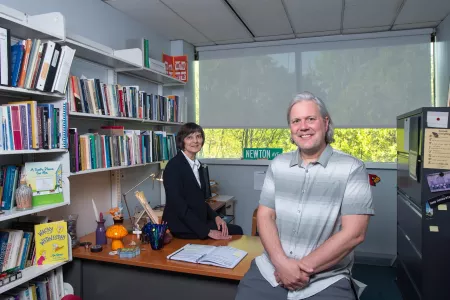Sweet emotion
December 2, 2024
UofL researchers study the language of love, hate and everything else. Photo by artist Susan Wilkinson.
What does it mean to be human?
It’s a question that spans millennia, and one each society and people has sought to answer through language. The result is thousands upon thousands of unique words, describing feelings, emotions, moods and sensations – what we taste, touch, smell, hear and see.
The words vary, slightly, from culture to culture. What English-speakers might call “happiness,” for example, could be compared to the Japanese “shinrin-yoku,” literally translating to forest bathing to describe the joy of a walk in the woods. Or, to the Croatian “fjaka,” meaning the sweetness of doing nothing. The Icelandic word “sólarfrí”, or sun vacation, captures the elation you experience when you get an unexpected day off from work.
Understanding the origins and nuances of these words could shed new light on human experience around the world, said Brendan Depue, a neuroscientist at the University of Louisville.
To achieve that goal, he and colleague Tamara Newton joined the Human Affectome Project, a global interdisciplinary task force of 173 scientists from 24 countries aimed at exploring these emotional linguistics. The result of the intercontinental research was an integrative framework for emotions and moods that could serve as a common focal point for further studies of the affective sciences.
Simply put, the task force laid out a plan to universally talk about your feelings.
“One might think emotion is a universal thing, and biologically, it is,” said Depue, an assistant professor and endowed chair of behavioral brain imaging and neurobiology at the College of Arts and Sciences. “We’re all born with basically the same hardware – the brain. But culture and other experiential inputs differ, and how we express that through linguistics can in turn reinforce and shape how we experience it.”
THE BRAIN MAY BE STEERING THE SHIP, BUT EMOTION IS ONE OF THE MOST OVERTLY OBSERVABLE PARTS OF HUMANITY AND BEING HUMAN. I’VE ALWAYS BEEN INTERESTED IN WHY HUMANS DO WHAT THEY DO, AND EMOTION IS INSIGHT INTO THAT.
- Brendan Depue
Think of the human brain like a computer. It comes preprogrammed with certain software for emotions – six basic ones, in fact, giving us capacity for happiness, sadness, anger, fear, disgust and surprise. Through our unique experiences and cultures, we gain new software that adds nuance (say, fjaka for happiness) and degrees of intensity (say, rage as a more intense degree of anger).
“This new research is meant to make our understanding of emotion much more inclusive of all of those factors that can help shape it,” said Newton, a professor of psychological and brain sciences in the College of Arts and Sciences. “There are all of these factors affecting our experiences that research just hasn’t considered before, such as voice, gender, race and culture.”
The task force scoured data from some 4.5 million books to identify more than 3,600 words in them describing sensations, emotions and moods. Then, 12 teams of researchers from different countries worked to group those words and connect them to what we know about emotions and feelings from current neuroscience research. Depue and Newton were the only faculty from Kentucky universities to participate.
Each of the global teams tackled a different area of emotion, from anger to happiness to motivation. Depue’s group focused on understanding words describing fear, while Newton focused on ones describing social interactions. Each group had a mix of researchers from different disciplines, which Depue said gave new insight into how words describing emotions are shaped and, in turn, shape us.
For example, imagine you’re going to miss an important work deadline. Your brain might experience your heart pumping and your palms sweating and name that emotion as “fear.” Because your brain knows that word, it can reference the emotion going forward or even invoke it. If you think of the word “fear,” you might associate it with that heart-pumping feeling or work stress.
That is, while our brains choose the words that describe our emotions, those words can then affect the way the brain experiences them.
“The brain may be steering the ship, but emotion is one of the most overtly observable parts of humanity and being human,” Depue said. “I’ve always been interested in why humans do what they do, and emotion is insight into that.”
Current research on the brain and emotions is fragmented, Newton said. It’s studied in pockets and often doesn’t include all of the various ways of examining human experience – through psychological interviews, through word choice and, as with Depue, by looking at the physical structure of the brain.
Newton hopes projects like the Human Affectome will create a more holistic body of research that could have dramatic and wide-ranging impacts, such as more comprehensive mental health treatments and artificial intelligence programs that better emulate human emotions.
“Anything we can do to work against the fragmentation of science is useful,” she said. “Hopefully by pulling this research together, we can help other researchers look at this in a more holistic way.”
To read and learn more, take a look inside the fall/winter 2024 issue of UofL Magazine.
Baylee Pulliam leads research marketing and communications at UofL, building on her experience as an award-winning business, technology, health care and startups reporter. She is a proud product of the UofL College of Arts and Sciences, where she earned her undergraduate degree in English. She also holds an MBA, a Master of Arts in Organizational Leadership and is pursuing a Ph.D. in the latter with a focus on corporate innovation.

